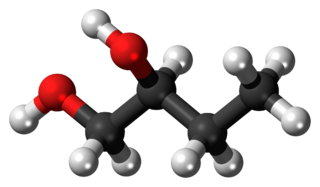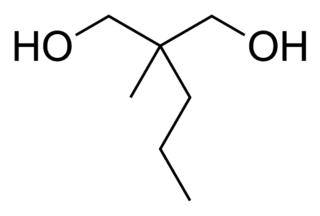Related Research Articles
In chemistry, a structural isomer of a compound is another compound whose molecule has the same number of atoms of each element, but with logically distinct bonds between them. The term metamer was formerly used for the same concept.

Petrochemicals are the chemical products obtained from petroleum by refining. Some chemical compounds made from petroleum are also obtained from other fossil fuels, such as coal or natural gas, or renewable sources such as maize, palm fruit or sugar cane.

In organic chemistry, a dicarbonyl is a molecule containing two carbonyl groups. Although this term could refer to any organic compound containing two carbonyl groups, it is used more specifically to describe molecules in which both carbonyls are in close enough proximity that their reactivity is changed, such as 1,2-, 1,3-, and 1,4-dicarbonyls. Their properties often differ from those of monocarbonyls, and so they are usually considered functional groups of their own. These compounds can have symmetrical or unsymmetrical substituents on each carbonyl, and may also be functionally symmetrical or unsymmetrical.
A diol is a chemical compound containing two hydroxyl groups. An aliphatic diol is also called a glycol. This pairing of functional groups is pervasive, and many subcategories have been identified. They are used as protecting groups of carbonyl groups, making them essential in synthesis of organic chemistry.

1,4-Butanediol, also called Butane-1,4-diol (other names include 1,4-B, BD, BDO and 1,4-BD), is a primary alcohol and an organic compound with the formula HOCH2CH2CH2CH2OH. It is a colorless viscous liquid first synthesized in 1890 via acidic hydrolysis of N,N'-dinitro-1,4-butanediamine by Dutch chemist Pieter Johannes Dekkers, who called it "tetramethylene glycol".
In organic chemistry, dihydroxybenzenes (benzenediols) are organic compounds in which two hydroxyl groups are substituted onto a benzene ring. These aromatic compounds are classed as phenols. There are three structural isomers: 1,2-dihydroxybenzene is commonly known as catechol, 1,3-dihydroxybenzene is commonly known as resorcinol, and 1,4-dihydroxybenzene is commonly known as hydroquinone.

A geminal diol is any organic compound having two hydroxyl functional groups (-OH) bound to the same carbon atom. Geminal diols are a subclass of the diols, which in turn are a special class of alcohols. Most of the geminal diols are considered unstable.
Dioxolane is a heterocyclic acetal with the chemical formula (CH2)2O2CH2. It is related to tetrahydrofuran (THF) by replacement of the methylene group (CH2) at the 2-position with an oxygen atom. The corresponding saturated 6-membered C4O2 rings are called dioxanes. The isomeric 1,2-dioxolane (wherein the two oxygen centers are adjacent) is a peroxide. 1,3-dioxolane is used as a solvent and as a comonomer in polyacetals.
Propanediol may refer to any of four isomeric organic chemical compounds:
1,3-Propanediol is the organic compound with the formula CH2(CH2OH)2. This 3-carbon diol is a colorless viscous liquid that is miscible with water.
The molecular formula C3H6O2 may refer to:
The molecular formula C3H8O2 may refer to:
Methanediol, also known as formaldehyde monohydrate or methylene glycol, is an organic compound with chemical formula CH2(OH)2. It is the simplest geminal diol. In aqueous solutions it coexists with oligomers. The compound is closely related and convertible to the industrially significant derivatives paraformaldehyde, formaldehyde, and 1,3,5-trioxane.

2,3-Butanediol is the organic compound with the formula (CH3CHOH)2. It is classified as a vic-diol (glycol). It exists as three stereoisomers, a chiral pair and the meso isomer. All are colorless liquids. Applications include precursors to various plastics and pesticides.

1,3-Butanediol is an organic compound with the formula CH3CH(OH)CH2CH2OH. With two alcohol functional groups, the molecule is classified as a diol. The compound is also chiral, but most studies do not distinguish the enantiomers. The compound is a colorless, bittersweet, water-soluble liquid. It is one of four common structural isomers of butanediol. It is used in flavoring.

1,2-Butanediol is the organic compound with the formula HOCH2(HO)CHCH2CH3. It is classified as a vic-diol (glycol). It is chiral, although typically it is encountered as the racemic mixture. It is a colorless liquid.

cis-2,3-Butylene carbonate is an organic compound with formula C
5H
8O
3, or (H3C)2(C2H2)(CO3). It is an ester with a carbonate functional group bonded to both free ends of the cis-2,3-butylene group. It is also a heterocyclic compound with a five-membered ring containing two oxygen atoms, and can be viewed as a derivative of dioxolane, namely cis-4,5-dimethyl-1,3-dioxolan-2-one.

1,2-Dimethylcyclopropane is a cycloalkane consisting of a cyclopropane ring substituted with two methyl groups attached to adjacent carbon atoms. It has three stereoisomers, one cis-isomer and a pair of trans-enantiomers, which differ depending on the orientation of the two methyl groups. As with other cyclopropanes, ring tension results in a relatively unstable compound.

Prenderol (Diethylpropanediol) is a simple alkyl diol which has sedative, anticonvulsant and muscle relaxant effects. It is closely related in structure to meprobamate and numerous other alkyl alcohols and diols with generally comparable activity.

2-Methyl-2-propyl-1,3-propanediol (MPP) is a simple alkyl diol which has sedative, anticonvulsant and muscle relaxant effects. It is both a synthetic precursor to, and an active metabolite of the tranquilizers meprobamate and carisoprodol, as well as other derivatives.
References
- ↑ "Butanediol". PubChem.
- ↑ "Propanediol, methyl-". PubChem.